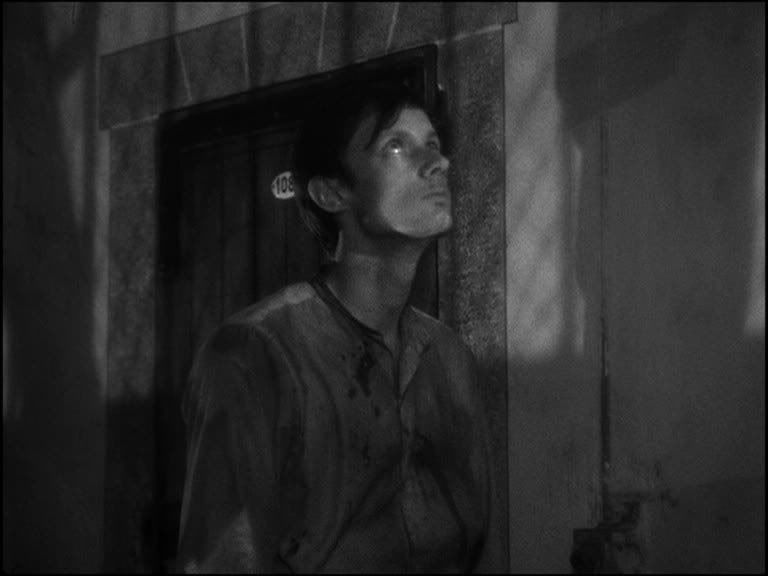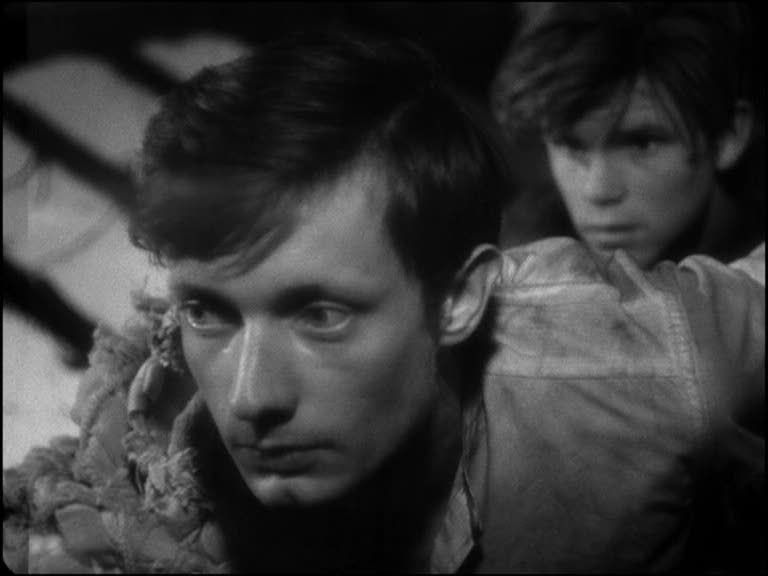
The opening minutes of Robert Bresson's A Man Escaped definitively establish what this film will be about. After the credits and a title card indicating the story's origins in true events, the first image is a tight closeup on a pair of hands turning over and over each other. Bresson slowly pulls back to reveal a prisoner sitting in the back of a car, looking at his hands, studying them, as though wondering what they can do. The message is clear: this will be a film about action, about the extent of what a man can do with his own two hands. The prisoner in this scene is Fontaine (François Leterrier), a young member of the French Resistance during World War II, who had been arrested and sentenced to death for blowing up a bridge. Bresson based the film on the real story of Resistance fighter André Devigny, and among other things this is a moving tribute to the strength of spirit of those brave enough to stand up for themselves in this way. Fontaine's spirit is never crushed, his desire for freedom never stifled, and his hopes never fade; from the moment he arrives in prison, his only thought from morning to night is of escape, of meticulously planning how he will get himself out of this seemingly inescapable fate.
Of course, whether Fontaine will actually escape or not is never in question, unless one manages to miss the title of the film. Bresson thus makes it clear right from the beginning that this will not be a tragedy, but somehow this foreknowledge never diminishes the incredible tension and suspense that builds up over the film's length. Bresson's style is simple and direct, with a minimalist approach that is perfectly suited to this milieu. The prisoners can only speak to each other, in furtive whispers, once a day, during their morning walk through the yard to wash up and empty their trash. At other times, they communicate by knocking coded messages on the walls of their cells, or climbing up to the high, barred windows where they can exchange a few words with their neighbors. There is thus very little dialogue, and what there is tends to be brusque, minimal, rushed, just a few economical phrases tossed back and forth whenever the guard is not looking. There is little opportunity for soul-baring expository speeches, and in any event one senses that Bresson is not interested. He says everything he needs to say through gestures, looks and sounds, using an abstracted, nearly mechanistic language.
Bresson's aesthetic is remarkably precise and controlled, stripping everything down to iconic actions and movements. Leterrier, like all of the other prisoners in the film, was completely untrained as an actor; he later became a writer and director but had never appeared in a film before, and indeed didn't appear in one again for over twenty years. As in most of Bresson's films, A Man Escaped is populated by untrained actors who could be molded, encouraged not to "act," to instead strip down their performances to a series of rote gestures. In the open air of Bresson's later Au hasard Balthazar, this economy of gesture and suppression of emotional expression could seem mechanical, even dehumanizing, but here the technique is remarkably appropriate to the prison setting. The characters are restrained, trapped in tiny box-like cells, their movements greatly restricted. In this milieu, the limited range of expression that Bresson allows his actors serves to magnify each gesture, each glance, each tiny movement. In his frequent closeups on hands — prefiguring Pickpocket — Bresson emphasizes the processes by which Fontaine prepares for his escape, the hard work of building makeshift ropes and grappling hooks or cutting loose the boards of his door. Leterrier, working with a very minimal palette of expressions, forces his feeling into his eyes; his face rarely registers much emotion, so the flitting movements of his eyes take on great significance. Bresson takes care to subtly underline this effect, making sure that the sparse light of the prison cell catches the pure white of the actor's eyes, imparting a spiritual quality to his upward glances, even if for Fontaine himself looking upwards means not so much God as freedom, the open sky above the constraining prison walls.

The film is economical, its structure rigid, with not a moment wasted. Each scene, each shot, slowly advances the preparations for escape, and the tremendous amount of time spent on each new development gives weight to Fontaine's predicament. He is working very hard, and it is always obvious how precarious his situation is, how easily all his work could be undone by the simple act of searching his room carefully, which the Germans never do. Despite the certainty of the ending, the suspense is often unbearable. This is because the film's perspective is always uncomfortably close to Fontaine's. The tight enclosure of his cell often seems to be encircling the audience as well, and Bresson never allows his camera to see more than what his main character can see at any given moment. There are frequent first-person views through peepholes or cracks in the cell door, but mostly Fontaine can only trace what is happening outside his room by listening, with a heightened sensitivity to every tiny noise. This sensitivity is translated into the film's soundtrack, which is unusually attentive to the nuances of sound: incidental creaks and groans, the knocking of the prisoners on their cell walls, the scratching of Fontaine's sharpened spoon against the wood of his door, echoing footsteps in another part of the prison, the sound of church bells somewhere far off, the gunfire that signals a death sentence being carried out, the bell-like ringing as a guard runs his key along the metal railing on his way upstairs. These sounds are what Fontaine uses to gauge his chances, to track the movements outside, where he can only guess at the location of guards and other potential hazards.
Throughout the film, Bresson is unfailingly precise in his use of sound, as in the rhythmic movements of the prisoners and the patient preparations of Fontaine for his escape. In the film's denouement, these preparations finally come together, as Fontaine and his boyish young cellmate Jost (Charles Le Clainche) break out together. Bresson's documentation of the actual escape is as formally exacting as everything else in the film, capturing not only the bursts of activity and action but also the quiet, patient waiting in between, like the long, breathless interval where Fontaine waits, his back pressed against a wall, listening to grow familiar with the patterns of a patrolling guard nearby. Bresson maintains a long, steady head-on shot of Fontaine, with the edge of the wall just at the far right side of the frame, barely suggesting the open space where the guard is walking back and forth offscreen. The audience knows the guard is there the same way Fontaine does: by the jingle of his belt buckle and the gravelly crunch of his boots on the courtyard ground. Fontaine's murder of this man happens offscreen as well, in this same black empty space at the far edge of the frame, signified only by the sounds of the scuffle.
Bresson's formal precision pays off in a film as intense and affecting as it is aesthetically spare. From its opening minutes to the discreet expression of joy at its denouement — a brief but sensuous (and even homoerotic) embrace between the two escapees — A Man Escaped is a powerful and beautiful film that mines great depths of feeling from its surface simplicity.

1 comment:
Ed,
I'm yet to see this film, I'm afraid.
Have you seen Bresson's LE PROCES DE JEANNE D'ARC? I read your review of JEANNE LA PUCELLE (both it and your review are great) and wondered if you'd seen Bresson's 'version'. I think they are both excellent and both superior to Dreyer's LA PASSION DE JEANNE D'ARC.
Post a Comment